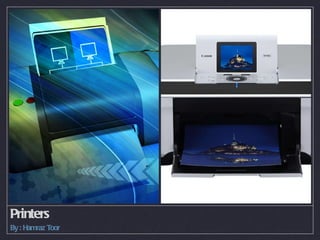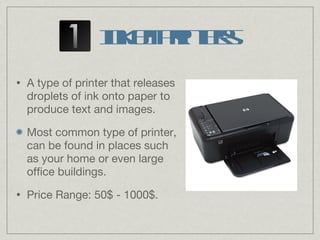Printer assigment
- 1. Printers By : Hamraz Toor
- 2. Overview Printers are peripherals which connect to computers and are used for printing text and images onto paper. The two most common and popular types of printers are inkjet and laser. Printers can come with scanning, photocopying, and fax functions.
- 3. History In China and Korea, printing can be dated back to 3000 BC. However, printing was popularized in the western world in the 16th century by Johannes Glutenberg. He invented the Glutenberg Press, which was a innovative machine that revolutionized printing. Historical Printing Methods: linotype, teletypesetter, phototypesetting, and silk screening.
- 4. What are the Four Main Types of Printers and how do They Work ?
- 5. Inkjet Printers A type of printer that releases droplets of ink onto paper to produce text and images. Most common type of printer, can be found in places such as your home or even large office buildings. Price Range: 50$ - 1000$.
- 6. Laser Printers A type of printer that uses a laser beam to transfer images onto paper. High end laser printers can print up to 100 pages per minute. Instead of cartridges, laser printers use toners. Price Range: $200 - $2000.
- 7. Dot-Matrix Printers A type of printer that produces text and images on paper using a matrix of pins that strike an inked ribbon. Not very popular compared the previous types of printers, no longer available in the market. Price Range: unavailable.
- 8. Thermal Printers A type of printer that produces a printed image by applying heat to thermochromic paper. Commonly used in stores to print out receipts. Price Range: 200$ - $1000
- 10. Connections to PC Printers can connect to PC’s in many ways including: PRINTER CABLE WIRELESS CONNECTIVITY ETHERNET CABLE
- 11. Information Processing Processing Printers receive information from computers, and then process it on to paper. Information such as texts or images can be transferred to printers and then printed. For the printer to understand the information, it must process it into its own language. Information is transferred through printer cables, ethernet cables, or wireless internet.
- 12. Printer Specifications Things to consider when buying a Printer: Resolution: What is the maximum of dots a printer can display on a paper? Print Speeds: How many pages per minute can a printer produce? Connectivity: How can the printer connect to your PC? (wireless internet, etc..) Paper Handling: What types of paper does your printer handle? (thermochromic, photo, etc...)
- 13. Future Trends Speed is a trend of the future for printers, companies are working on a printer that can print 2 pages per second. It is also speculated that ink less printers are being developed. Toshiba is working on a printer that allows you to print, erase, and re-print on a single sheet of paper. 3D printers will also be a trend in the future.
- 14. Leading Printer Manufacturers Hewlett-Packard Epson Canon Lexmark Xerox Samsung
- 15. Bibligraphy http://inventors.about.com/od/pstartinventions/a/printing.htm http://www.historyworld.net/wrldhis/PlainTextHistories.asp?historyid=ab78 http://www.cleverace.com/Printer_types.htm http://reviews.cnet.com/4520-7604_7-1016838-3.html














